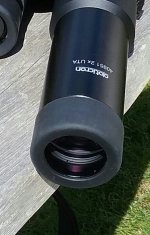Chosun,
I've got two wine containers here, one has a volume of 24.5l and the other 19.5l. Is that useful information when they both contain 12 bottles or 9l of wine? (Actually the contents is long gone.B

) Likewise ER is a gross measurement and available ER is the nett measurement. The current ISO regulation seems to allow either to be used without specifying which. Seems ridiculous to me and may explain some of the problems you mention. There is no more inherent wriggle room with available ER than there is with the full ER. I'd still argue the nett ER is the more useful mesurement for punters like us.
David
David,
I had a bad experience with wine when I was 15, so yes I would find that information useful - steer clear of the contents! :-O

I agree, the current Standard as specified has too great a tolerance. If(?) this was done to allow some sellers to save minor costs by maintaining their current print/spec material, then the ensuing apples to oranges comparison confusions are too high a cost to pay. Tightening this to +/-0.5mm would be a once off relatively painless hit to the marketing budget. Then everyone industry wide is comparing the same apples to apples total ER measurement.
What I was getting at (and in a basic form what you are getting at for your case too

is that a simple ISO measurement of total ER as currently defined, but to a greater tolerance of +/-0.5mm leaves the least amount of wiggle room (chance for unscrupulous, or less than precise sellers to fudge the numbers).
Of course, as per your case, you could make a measurement of the
bin's available ER (ie coaxially from the rim of the eye cup to the perpendicular plane of the convergence point) to the same tolerance. :cat:
BUT, this will not always bear good correlation to a particular user's available ER requirements, due to all of those facial characteristics and spectacle script, curvatures, and offsets etc that we have mentioned. There would be several mm of potential discrepancy depending on just where on the bell curve an individual sits and how wide the ocular diameter is, and how this all marries up. You would end up saying I need 14mm 'available bin ER' with Bin A, 15mm with Bin B, 14.5mm with Bin C, 16mm with Bin D, etc, etc. I just think it is less precise for the consumer.
The ISO total ER measurement is also a fundamental physical property of the bin's design, useful for all sorts of rudimentary ER/Fov/Weight, etc back of the envelope calculations when comparing different bin designs. I'd hate to see that precise figure get lost in reams of marketing spin - scurrilous or otherwise! :eek!: , Chinglish, superceded Print material, and Website errors ..... :-C
I have some interest in the 10x MHG, we will have to see how sorted they manage to get it optically, and how I find the ER, CA - it could be a while before I can get my hands on one. I hope all of this doesn't drive you to drink! B

Chosun :gh:






